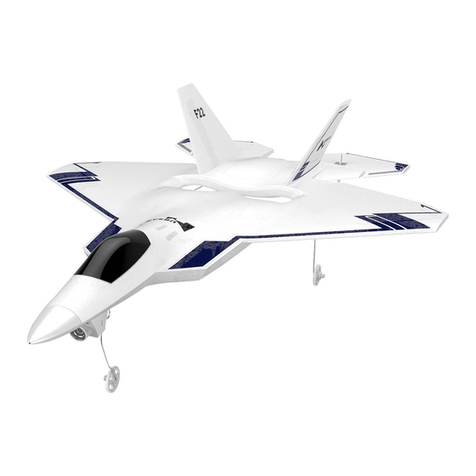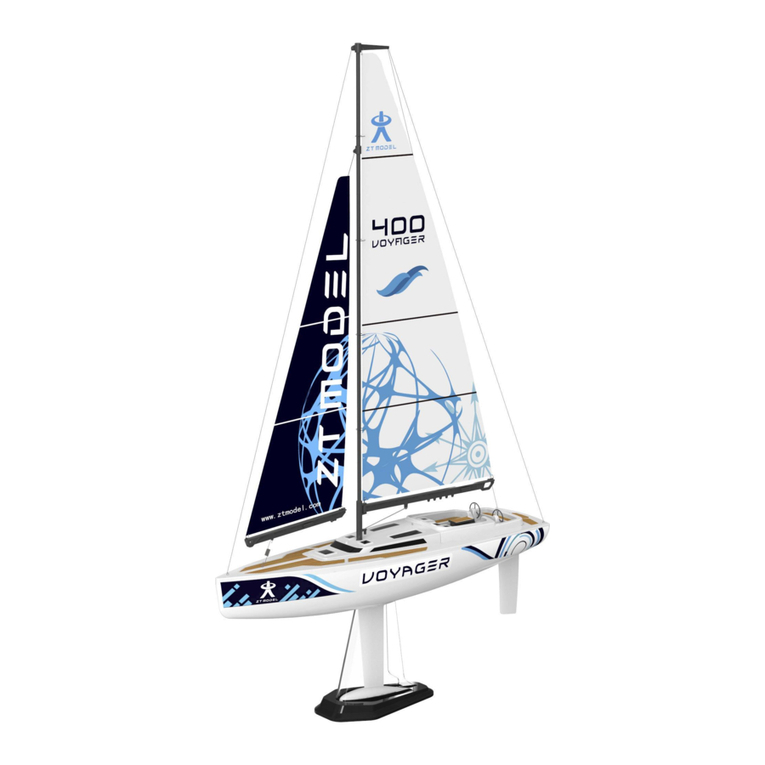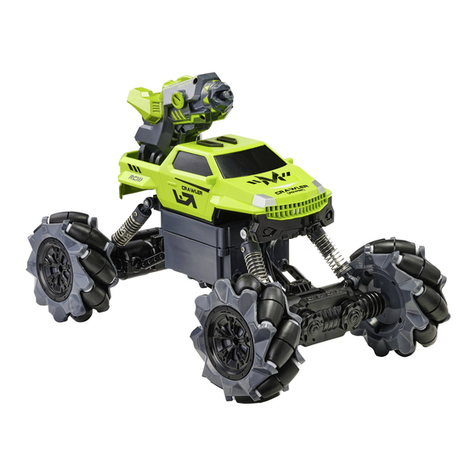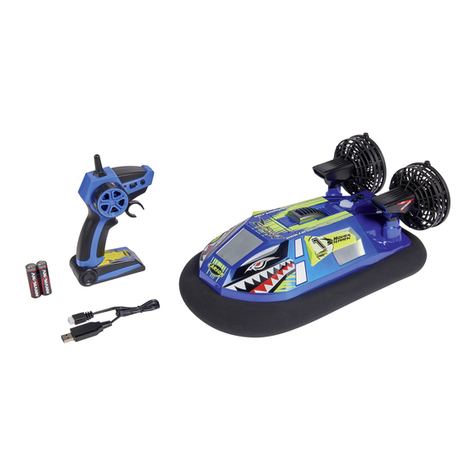
Avoid the following unfavourable environ-
mental conditions at the place of use, and
during transportation:
– Wetness or high humidity
– Cold or heat, direct sunlight
– Dust or ammable gases, fumes or
solvents
– Strong vibrations, impacts or blows
– Strong magnetic elds, such as those
found close to machinery or speakers
Never use the charger/power cord im-
mediately after it has been brought from a
cold room to a warm one. Otherwise, this
may result in the formation of condensate,
which can destroy the charger under cer-
tain circumstances. There is also a risk of
death from an electric shock! Allow the
product to reach room temperature before
connecting it and putting it into use. This
may take several hours.
Make sure that the charger power cord is
not kinked or crushed. The same applies
to the cables of the LiPo rechargeable
battery.
Handle the product with care, because it
can be damaged by jolts, impacts or a fall
from a low height.
4.3 Before operation
Ensure that there are no other models op-
erating at the same frequency (2.4 GHz)
within range of the remote control. Always
check whether there are any other 2.4
GHz remote controls that may interfere
with the model.
Conduct regular checks to verify that the
model and remote control are safe to use.
Inspect the parts for any visible signs of
damage, such as broken connectors or
damaged cables. All moving parts on the
model should move freely, but there must
not be any slackness in the bearing.
The drive battery that is required for op-
eration must be charged before use.
Ensure that the batteries in the transmitter
have sufcient remaining capacity (use a
battery tester). If the batteries are empty,
replace all of them at the same time. Nev-
er replace individual batteries.
Before each use, check the trim settings
for different control directions on the re-
mote control, and if necessary, adjust
them.
Before every use, check that the propeller
is correctly and securely seated and that
it is intact.
When switching on the remote control
and putting the model boat into operation,
always follow the procedure described
below in a separate section. This ensures
that the transmitter and receiver are con-
nected properly and that your model
responds reliably to remote control com-
mands from your transmitter. Otherwise,
the receiver may react unpredictably and
the propeller may accidentally start up.
There is a risk of accident and injuries!
Keep objects and body parts away from
the propeller’s spinning and intake area
when it is running.
4.4 During use
Do not take any risks when using the prod-
uct! Always use the model responsibly,
otherwise you may endanger yourself and
your surroundings.
Improper use can cause serious injury and
damage to property! Always ensure that
the model boat is kept away from people,
animals and objects during use.
Select a suitable body of water to use your
model. Make sure you ask the person or
organisation responsible for the body of
water whether you are permitted to use
your model there.
Ensure that there are no climbing plants
(such as seaweed) in the water. In addi-
tion, check that there are no objects (e.g.
branches) oating in the water.
When aoat, pay attention to currents and
other adverse conditions that make it dif-
cult or even impossible to operate the
model. The model can even be destroyed!
The model boat should only be operated
in still or very slow-owing waters without
signicant wave formation due to its small
size and relatively high potential speed.
Only use the model when you are fully
alert and able to respond. Fatigue, alcohol
and medication can affect your ability to
respond.
Never drive the model boat directly at
people or animals that are swimming in
the water.
Should any malfunctions occur during
operation, which may result in the model
boat drifting uncontrollably and/or with-
out propulsion in the water or e.g. getting
stuck in water plants, do not put your life in
danger while attempting to retrieve it from
the water.
Do not take any risks when retrieving the
model boat. Watch out for currents and
other boat trafc in the body of water. If
necessary, use an aid to retrieve the mod-
el boat from the water (e.g. rowing boat).
Never attempt to retrieve the model boat
alone, always engage an assistant who
can observe what is happening around
and call for help in an emergency.
Never point the transmitter antenna di-
rectly onto the model. This makes the sig-
nal transmission to the model a lot worse.
You should hold the transmitter so that the
transmitter antenna points upwards as
much as possible.
The motor, speed controller and drive
battery can become hot during model
operation. For this reason, wait 5 to 10
minutes before recharging the drive bat-
tery or restarting the model with a spare
rechargeable battery. Let the drive motor
and speed controller cool down to the am-
bient temperature.
Always keep the remote control (transmit-
ter) turned on when the model is in use.
Always disconnect the drive battery from
the model after use. Only then may the
transmitter be switched off.
In the event of a defect or malfunction,
be sure to eliminate the cause of the fault
before resuming operation of the model.
Do not expose the model or the remote
control to direct sunlight or excessive heat
for prolonged periods.
Safety Instructions
Item No. 2611682
1 Intended use
This product is an electrically driven model
boat which is controlled wirelessly via a 2.4
GHz remote control provided.
The model is designed for outdoor use, but it
must only be used in freshwater. The remote
control and drive components, drive battery,
transmitter and charger/power cord must be
protected from moisture and humidity.
This product is not a toy and is not suitable for
children under 14 years of age.
Always follow the safety informa-
tion in these operating instructions.
They contain important information
on how to use the product safely.
Read the entire operating instruc-
tions carefully before getting start-
ed and operating the model boat.
You are solely responsible for the
safe operation of the product!
2 Latest product information
Download the latest product information at
www.conrad.com/downloads or scan the QR
code shown. Follow the instructions on the
website.
3 Description of symbols
The symbol warns of hazards that
can lead to personal injury.
The symbol warns of dangerous
voltage that can lead to personal
injury by electric shock.
4 Safety instructions
Read the operating instructions
carefully and especially observe
the safety information. If you do
not follow the safety instruc-
tions and information on proper
handling in this manual, we as-
sume no liability for any result-
ing personal injury or damage to
property. Such cases will invali-
date the warranty/guarantee.
4.1 General
Caution, safety hazard!
This model has the potential to cause dam-
age to property and/or individuals. Ensure that
you are sufciently insured, e.g. by taking out
private liability insurance. If you already have
a policy, check with your insurance company
that use of this model is covered by the policy.
Please note: Some EU countries prohibit the
use of model boats in certain bodies of water.
The unauthorised conversion and/or
modication of the product is prohibited
for safety and approval reasons.
This product is not a toy and is not suitable
for children under 14 years of age.
The remote control and drive components
must not become damp or wet.
The model boat is only suitable for use in
fresh water.
If you do not have sufcient knowledge of
how to operate remote-controlled model
boats, contact an experienced model en-
thusiast or a model retailer.
Do not leave packaging material unattend-
ed, as it may become dangerous playing
material for children.
If you have any questions that are not
answered by these operating instructions,
contact us or an experienced technician.
4.2 Charger
The design of the battery charger con-
forms to protection class II. The charger
must be connected to a properly grounded
mains socket of the public supply grid (for
charger operating voltage, see section
“Technical data”).
The mains socket the charger is plugged
into via the power cord must be easily ac-
cessible.
The charger is only suitable for charg-
ing 2- or 3-cell LiPo rechargeable bat-
teries. Never use the charger for any
other purpose. Never use the charger to
charge NiMH rechargeable batteries (or
rechargeable batteries other than 2- or
3-cell LiPo ones) to avoid the risk of re
and explosion!
Only insert a single LiPo rechargeable
battery into the charger (the two outputs
must never be used at the same time).
The charger has XH sockets for connect-
ing the LiPo rechargeable battery. The
rechargeable battery must also have a
corresponding XH connector, otherwise
matching adapters are required. Always
pay attention to the correct pin assign-
ment.
Never short-circuit the charger outputs
and never connect the outputs together.
The charger may only be used in dry, en-
closed spaces. It must be protected from
moisture and dampness; never touch it
with wet hands to avoid the risk of death
from an electric shock! The same applies
to the power cord and mains plug.
Do not pull the mains plug out of the mains
socket by the cable. Grasp the plug by the
side of the housing and pull it out of the
mains socket.
If the charger and/or the power cord shows
signs of damage, do not touch it to avoid
the risk of death from an electric shock!
First switch off the mains voltage for the
mains socket the charger is plugged into
(switch off the associated circuit breaker
or unscrew the fuse, then switch off the
ground fault circuit interrupter so that the
mains socket is completely disconnected
from the mains voltage). You can then
unplug the power cord from the mains
socket.
Dispose of the damaged charger/power
cord in an environmentally friendly man-
ner and do not use it anymore. Make sure
you use a structurally identical charger/
power cord instead. A defective power
cord must never be repaired!
Mains-operated devices should not be
used by children. Therefore, be especially
careful when children are around. When
using the charger, always make sure that
children cannot reach it.
































